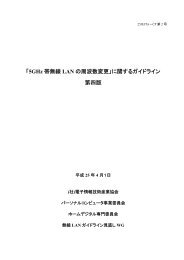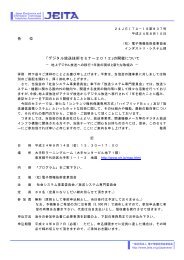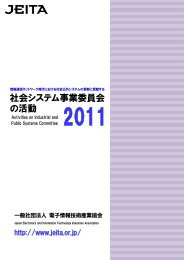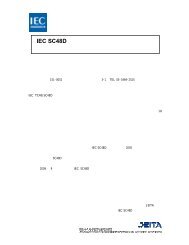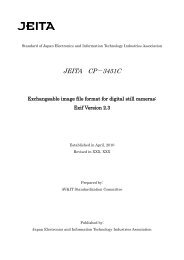3.3V±0.3V (Normal Range), and 2.7V to 3.6V (Wide Range ... - JEITA
3.3V±0.3V (Normal Range), and 2.7V to 3.6V (Wide Range ... - JEITA
3.3V±0.3V (Normal Range), and 2.7V to 3.6V (Wide Range ... - JEITA
Create successful ePaper yourself
Turn your PDF publications into a flip-book with our unique Google optimized e-Paper software.
EIAJ ED-5001A<br />
St<strong>and</strong>ard of Japan Electronics <strong>and</strong> Information Technology Industries Association<br />
<strong>3.3V±0.3V</strong> (<strong>Normal</strong> <strong>Range</strong>), <strong>and</strong> <strong>2.7V</strong> <strong>to</strong> <strong>3.6V</strong> (<strong>Wide</strong> <strong>Range</strong>)<br />
Power Supply Voltage <strong>and</strong> Interface St<strong>and</strong>ard for<br />
Nonterminated Digital Integrated Circuit<br />
1. Interface St<strong>and</strong>ard<br />
1.1 Purpose<br />
To provide this st<strong>and</strong>ard of specifications for uniformity, multiplicity of sources, elimination of<br />
confusion, <strong>and</strong> ease of device specification <strong>and</strong> design by users.<br />
1.2 Scope<br />
This st<strong>and</strong>ard defines power supply voltage ranges, DC interface parameters for a family of<br />
nonterminated digital circuits operating from a power supply of 3.3V <strong>and</strong> driving/driven by parts of the<br />
same family, or mixed families which comply with the input/output interface specifications.<br />
The specifications in this st<strong>and</strong>ard represent a minimum set or "base line" set of interfaces for<br />
LVTTL-compatible <strong>and</strong> LVCMOS-compatible circuits.<br />
2. St<strong>and</strong>ard specifications<br />
All voltages listed are referenced <strong>to</strong> ground except where noted.<br />
2.1 Absolute maximum continuous ratings<br />
Table 1 Absolute maximum continuous ratings Note 1<br />
Parameter Symbol Test condition Rating Unit<br />
Power supply voltage VDD -0.5 ~4.6 V<br />
DC input voltage VIN excluding I/O pins -0.5~VDD+0.5(≦4.6 max) V<br />
DC output voltage VOUT including I/O pins -0.5~VDD+0.5(≦4.6 max) V<br />
DC input current IIN VINVDD ±20 mA<br />
DC output current IOUT VOUTVDD ±20 mA<br />
S<strong>to</strong>rage temperature range TSTG Note 2 ℃<br />
Note 1: Absolute maximum continuous ratings are those values beyond which damage <strong>to</strong> the device may<br />
occur. Exposure <strong>to</strong> these conditions or conditions beyond those indicated may adversely affect<br />
device reliability. Functional operation under absolute maximum conditions is not implied, if it<br />
is beyond recommended operating conditions.<br />
Note 2: Specified by manufacturer for various purposes, respectively.
EIAJ ED-5001A<br />
2.2 Recommended operating conditions<br />
Table 2 Recommended operating conditions<br />
Parameter Symbol <strong>Normal</strong> range (3.3V nominal) <strong>Wide</strong> range (3V nominal) Unit<br />
Power supply voltage VDD 3.0 ~3.6 2.7~3.6 V<br />
Operating temperature range Ta Note 3 Note 3 ℃<br />
Note 3: Specified by manufacturer for various purposes, respectively.<br />
2.3 DC specifications<br />
All specifications in the following tables apply across the operating temperature range.<br />
Table 3 LVTTL & LVCMOS input specifications<br />
<strong>Wide</strong> range ( 3V nominal):VDD (min) =<strong>2.7V</strong>, V DD (max) = <strong>3.6V</strong><br />
<strong>Normal</strong> range (3.3V nominal):VDD (min) =3.0V, V DD (max) = <strong>3.6V</strong><br />
Parameter Symbol Test condition Note 4 Min Max Unit<br />
High-level input voltage VIH 2.0 VDD+0.3 V<br />
or<br />
Low-level input voltage VIL<br />
-0.3 0.8 V<br />
Input current IIN<br />
VOUT≧ VOH (min)<br />
VOUT≦ VOL (max)<br />
VIN = 0V or<br />
VIN = VDD Note 5<br />
±5 μA<br />
Note 4: For conditions shown as `min` or `max`, use the appropriate value shown in Table 4 <strong>and</strong> Table<br />
5.<br />
Note 5: Excluding common input/output terminals.<br />
Table 4 LVTTL output specifications<br />
<strong>Normal</strong> range (3.3V nominal): V DD (min) = 3.0V, V DD (max) = <strong>3.6V</strong><br />
Parameter Symbol Test condition Min Max Unit<br />
High-level input voltage VOH VDD = min, IOH = -2mA 2.4 V<br />
Low-level input voltage VOL VDD = min, IOL = 2mA 0.4 V<br />
Table 5 LVCMOS output specifications<br />
<strong>Wide</strong> range ( 3V nominal):V DD (min) = <strong>2.7V</strong>, V DD (max) = <strong>3.6V</strong><br />
<strong>Normal</strong> range (3.3V nominal):V DD (min) = 3.0V, V DD (max) = <strong>3.6V</strong><br />
Parameter Symbol Test condition Min Max Unit<br />
High-level input voltage VOH VDD = min, IOH = -100μA VDD-0.2 V<br />
Low-level input voltage VOL VDD = min, IOL = 100μA 0.2 V
EIAJ ED-5001A<br />
2.4 Optional DC electrical characteristics for Schmitt trigger operation<br />
All specifications in the following tables apply across the operating temperature range.<br />
2.4.1 Optional Schmitt trigger operation – 3.3V <strong>Normal</strong> range<br />
Table 6 3.3V <strong>Normal</strong> range Note 6 <strong>and</strong> 7<br />
Symbol Parameter Test Condition MIN MAX Unit<br />
V DD Supply Voltage --- 3.0 3.6 V<br />
Vt+ (Vp )<br />
Vt- (Vn )<br />
Positive Going Threshold<br />
Voltage<br />
Negative Going Threshold<br />
Voltage<br />
V OUT≧V OH (min) 0.9 2.1 V<br />
V OUT≦V OL (max) 0.7 1.9 V<br />
VH (⊿Vt) Hysteresis Voltage Vt+ - Vt- 0.2 1.4 V<br />
V OH<br />
V OL<br />
Output High Voltage<br />
Output Low Voltage<br />
I OH= -100μA<br />
I OH= -2mA<br />
I OL= 100μA<br />
I OL= 2mA<br />
V DD-0.2<br />
Note 6: VDD of the sending <strong>and</strong> receiving devices must track within 0.1 V <strong>to</strong> maintain adequate dc margins.<br />
Note 7: For Vt+ (Vp) <strong>and</strong> Vt- (Vn), VDD refers <strong>to</strong> the receiving device. For VOH <strong>and</strong> VOL, VDD refers <strong>to</strong> the<br />
sending device.<br />
2.4.2 Optional Schmitt trigger operation – 3.3V <strong>Wide</strong> range<br />
Table 7 3.3V <strong>Wide</strong> range Note 8<strong>and</strong> 9<br />
Symbol Parameter Test Condition MIN MAX Unit<br />
V DD Supply Voltage --- 2.7 3.6 V<br />
Vt+ (Vp )<br />
Vt- (Vn )<br />
Positive Going Threshold<br />
Voltage<br />
Negative Going Threshold<br />
Voltage<br />
2.4<br />
―<br />
―<br />
―<br />
0.2<br />
0.4<br />
V OUT≧V OH (min) 0.9 2.1 V<br />
V OUT≦V OL (max) 0.7 1.9 V<br />
VH (⊿Vt) Hysteresis Voltage Vt+ - Vt- 0.2 1.4 V<br />
V OH Output High Voltage I OH= -100μA V DD-0.2 ― V<br />
V OL Output Low Voltage I OL= 100μA ― 0.2 V<br />
Note 8: VDD of the sending <strong>and</strong> receiving devices must track within 0.1 V <strong>to</strong> maintain adequate dc margins.<br />
Note 9: For Vt+ (Vp) <strong>and</strong> Vt- (Vn), VDD refers <strong>to</strong> the receiving device. For VOH <strong>and</strong> VOL, VDD refers <strong>to</strong> the<br />
sending device.<br />
V<br />
V
EIAJ ED-5001A<br />
3 Test conditions<br />
3.1 Positive Going Threshold Voltage : Vt+ (Vp)<br />
Input signal is raised from a gr<strong>and</strong> level in the measurement circuit shown in Fig. 1 , <strong>and</strong> the input<br />
voltage value of which output logic changed is determined as Vt+ (Vp).<br />
3.2 Negative Going Threshold Voltage : Vt- (Vn)<br />
Input signal is dropped from a power supply voltage level in the measurement circuit shown in Fig.<br />
1 , <strong>and</strong> the input voltage value of which output logic changed is determined as Vt- (Vn).<br />
Fig. 1 DC characteristic measurement circuit of Schmitt-trigger input
EIAJ ED-5001A<br />
1. Purpose of establishment<br />
Explana<strong>to</strong>ry note<br />
This st<strong>and</strong>ard is enacted <strong>to</strong> accomplish a high speed <strong>and</strong> a low voltage operation for digital integrated<br />
circuits.<br />
This st<strong>and</strong>ard defines power supply voltage ranges, DC interface parameters for a family of<br />
nonterminated digital circuits operating from a power supply of 3.3V <strong>and</strong> driving/driven by parts of the<br />
same family, or mixed families which comply with the input/output interface specifications.<br />
2. Review of discussion his<strong>to</strong>ry<br />
JEDEC JC-16 (Low Voltage & High Speed Interface Sub-committee), called JEDEC after here,<br />
which belongs <strong>to</strong> EIA (Electronic Industries Association of U.S.A), enacted substantially the st<strong>and</strong>ard<br />
of power supply voltage for digital circuits in the world.<br />
IC Low Voltage Operation Sub-committee which belongs <strong>to</strong> EIAJ(Electronic Industries Association of<br />
Japan) has been cooperation with JEDEC <strong>and</strong> communicated mutually, since it was founded in 1992.<br />
A power supply voltage of digital circuits had been kept 5V,actually for a long time from 1980’s. But,<br />
in 1990’s, a requirement of low power supply voltage has become increasing <strong>to</strong> attain a low power<br />
consumption <strong>and</strong> a high noise immunity of electric equipments, in a main application of portable<br />
equipments (note PC, etc) which need a long battery operation <strong>and</strong> high performance equipments (WS,<br />
etc) which require a high speed.<br />
In 1990’s, also an age of deep sub-micron process technology (below 0.5μm process technology) has<br />
begun. Needs of low power supply voltage have become the most important issue <strong>to</strong> obtain a keeping<br />
of reliability <strong>and</strong> continuities of the trends of high density, high speed, <strong>to</strong>gether.<br />
According <strong>to</strong> above back ground, discussion for st<strong>and</strong>ard of low power supply voltage, firstly<br />
3.3V,have begun in JEDEC, from early of 1990’s. 3.3V st<strong>and</strong>ard (JESD8-A) was enacted in<br />
June,1994, 2.5V st<strong>and</strong>ard (JESD8-5) was in Oc<strong>to</strong>ber, 1995 <strong>and</strong> 1.8V st<strong>and</strong>ard (JESD8-7) was in<br />
February, 1997, respectively.<br />
Especially, 3.3V JEDEC st<strong>and</strong>ard(JESD8-A) was required <strong>to</strong> maintain 5V TTL <strong>and</strong> 5V CMOS<br />
compatibility, because both 5V <strong>and</strong> 3.3V power supply voltages were used in a transition period from<br />
5V <strong>to</strong> 3.3V when it was a first case of lower power supply voltage. To obtain a 5V compatibility, this<br />
st<strong>and</strong>ard defined a specifications of LVTTL <strong>and</strong> LVCMOS.<br />
IC Low Voltage Operation Sub-committee began the discussion for st<strong>and</strong>ard of low power supply<br />
voltage since April, 1996 in EIAJ, according <strong>to</strong> JEDEC's activities of power supply discussion, in<br />
anticipation of a real popularization of 3.3V power supply voltage from the half of 1990’s <strong>and</strong> coming<br />
of next lower supply voltage than 3.3V.<br />
EIAJ st<strong>and</strong>ard of 3.3V power supply voltage was established in May, 1998. This st<strong>and</strong>ard<br />
corresponds <strong>to</strong> that of JEDEC about specifications, because it has been already known <strong>and</strong> used<br />
widely in the world. But, this st<strong>and</strong>ard is amended from that of JEDEC about notation <strong>and</strong> sentence<br />
for accomplishing the unify of them among three JEDEC st<strong>and</strong>ards (3.3V, 2.5V, 1.8V).
EIAJ ED-5001A<br />
After st<strong>and</strong>ardizing the dc st<strong>and</strong>ard, discussion on Schmitt trigger input st<strong>and</strong>ard was started by <strong>JEITA</strong> /<br />
LVSC in February 2003. <strong>JEITA</strong>/LVSC submitted its proposed Schmitt trigger input st<strong>and</strong>ard <strong>to</strong> JEDEC<br />
in March 2004, for the first time. JEDEC’s discussion on Schmitt trigger input st<strong>and</strong>ard was begun by<br />
this proposal. The task-group was organized by <strong>JEITA</strong> / LVSC <strong>and</strong> JEDEC at the JEDEC meeting in<br />
June 2004. It has decided that the proposal of Schmitt trigger st<strong>and</strong>ard <strong>to</strong> be added in<strong>to</strong> existing dc<br />
st<strong>and</strong>ard. Finally, the proposal of Schmitt trigger input st<strong>and</strong>ard was approved at the JEDEC meeting in<br />
December 2004. Based on the result of JEDEC meeting, <strong>JEITA</strong>’s revised st<strong>and</strong>ard of 3.3V power<br />
supply voltage was revised as ED-5001A in May 2005.<br />
3. Members of discussion<br />
This st<strong>and</strong>ard has been discussed by the IC Low Voltage Operation Sub-committee which belongs <strong>to</strong><br />
Group on Integrated Circuits of Technical St<strong>and</strong>ardization Committee on Semiconduc<strong>to</strong>r Devices.<br />
The members are shown as following.<br />
<br />
Chairman Hisao Kasuga NEC Corp.<br />
<br />
Chairman Hisao Kasuga NEC Corp.<br />
<br />
Chairman Haruyoshi Takaoka Fujitsu Ltd.<br />
Vice-chairman Kohji Hosokawa IBM Japan, Ltd.<br />
Member Masahiro Kurimo<strong>to</strong> Oki Electric Industry Co.,Ltd.<br />
Hidemitsu Baba SANYO Electric Co.,Ltd.<br />
Koji Inoue Sharp Corp.<br />
Akira Nakada Seiko Epson Corp.<br />
Mitsuo Soneta Sony Corp.<br />
Masanori Kinugasa Toshiba Corp.<br />
Takashi Akioka Renesas Corp.<br />
Takefumi Yoshikawa Matsushita Electric Industrial Co.,Ltd.<br />
Aki<strong>to</strong>shi Watanabe Rohm Co.,Ltd.<br />
Guest Kazuo Yamaguchi TOSHIBA LSI System Support Corp.<br />
Osamu Uno Fujitsu VLSI Ltd.




